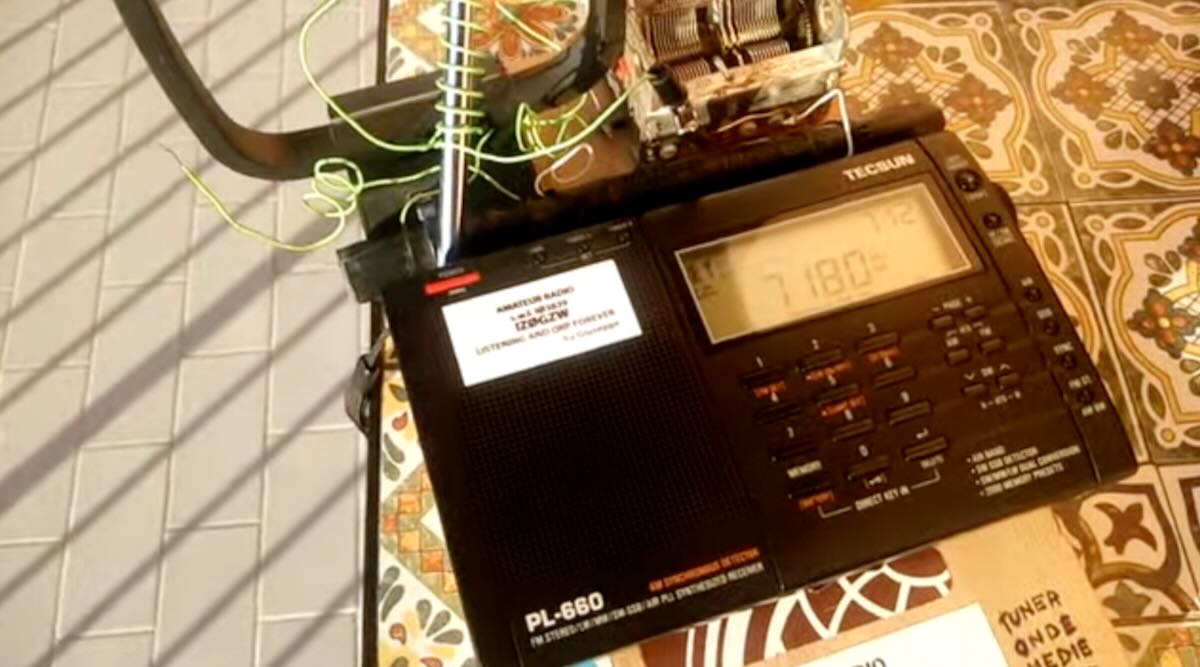Many thanks to SWLing Post contributor, Giuseppe Morlè (IZ0GZW), who shares the following:
Dear Thomas and Friends of SWLing Post …
This is Giuseppe Morlè. As always, I try recycling what I have and improving upon antennas I’ve built in the past. This is one way we radio lovers can experiment. Many years ago, I made an antenna only for medium waves; by adding a circuit, I can now listen to short waves.
I took advantage of a small frame that I recovered from an old commercial FM / AM stereo receiver by removing its coils for medium waves and I wound around it only two coils sufficient to have a frequency range from 3.5 to 18 MHz.
I remember that the antenna in question also receives medium waves as it was born.
I chose this small frame because I wanted everything to be small in order to carry this compact antenna everywhere.
Unlike my other projects for SW and MW, which have a cable that carries the SW signal to the receiver, this time I used the induction that is created around one end of the loop, which I spiraled to get inside the stylus of my Tecsun PL-660 and which then transfers the signal to the receiver.
I did some tests on my balcony the day after a strong storm and I noticed that the propagation was absent but I still wanted to make sure that everything was working.
[Note that you can translate this video into your language via YouTube’s automatic subtitles. Click here to learn how to do this.]
I will keep you updated on other tests on more favorable days of propagation … I still invite you to follow me on my Youtube channel.
I wish everyone a good listening …
73. Giuseppe Morlè iz0gzw.
Many thanks, Giuseppe. I, for one, love all of your homebrewed and recycled antennas. This one is no exception! What a fun project. I love how you use what you have and aren’t afraid to experiment! Thank you for sharing.


Now we must make the count 1,001 as I have subscribed to your Youtube channel also.
73, Guiseppe!
Franz
Thanks Franz,
I hope to do something interesting for all friends with my little things…
Thanks to you and to all those who have fun, with little, with me.
73. Giuseppe.
Giuseppe,Thanks and Well Done.It sure looks like you have a fantastic listening post on your balcony.In panning your camera/phone I saw a great horizon looking out and lots of water for signal bounce.I am envious,keep on experimenting,that is a great part of the fun and good luck
Thanks Jack,
I live in a small town on the Lazio coast in central Italy, Formia, and I live not far from the sea…
my balcony is a place of experiments especially in summer and spring and it’s actually an excellent listening point…
a sincere greeting and good listening to you.
73. Giuseppe.
I do rent a small cabin several times a year for about 10 days in a mountain area with many trees to hang a 60′ dipole.Reception is outstanding,sometimes I run two ant.,one E &W,the other N & S with a seperator switch,just for fun.At home no rooftop antennas can be run,anymore,so I enjoy my trips to the cabin thoroughly.Happy listening and experimenting !
Thanks adi,
I created this channel for local friends…
however, I’m not very attentive to the “modernity” of today…
I film with a simple phone live as it comes…
I didn’t think my videos could be of interest to many…thanks again.
73. Giuseppe.
That’s a great little antenna system you devised. I wish the audio in the video was in English so I could have a better understanding of exactly what you did and your comments about it. Thanks for sharing the video.
Thanks John,
unfortunately I can understand English but I speak little and I don’t want to make mistakes…
try the instant google translator that helps me a lot…
this is a very simple circuit with recycled materials that seems to work well by induction even on short waves…
greetings from Italy.
73. Giuseppe.
You can use English automated subtitles by clicking on settings while watching the video,it worked for me.Regards
Hi, John,
Note that you can translate this video into English effortlessly via YouTube’s automatic subtitles. Click here to learn how to do this: https://youtu.be/LZz03myFuWA
Cheers,
Thomas
To create a larger air core loop antenna that can be collapsed to small size carry around a bicycle inner tube and a “ribbon cable” whose individual wires can be connected to create one, two, three four, etc loops. Blow up the inner tube, wrap the ribbon cable around it helix like, then let the air out to pack it in a small container to travel.
Honestly, I understood little … it looks like me when I organize something …
Thanks anyway.
Hi Giuseppe, Henry’s idea is pretty simple, it’s an “inflatable loop” 😀
Prendi una camera d’aria di bicicletta, la gonfi e ci avvolgi attorno, a spirale, un cavo piatto multiconduttori, fissandolo alla camera d’aria, i conduttori del cavo potranno quindi essere connessi in serie tra loro per formare un loop con 1, 2… “n” spire; per trasportare il loop sarà sufficiente sgonfiare la camera d’aria e riporla
hope it’s clear now 😀
AhAhAh…grazie Andrew, credo sia proprio così…
73. Giuseppe.
Great Video, I saw you had 999 so I subscribed to be your 1000